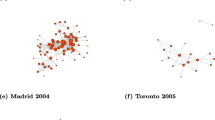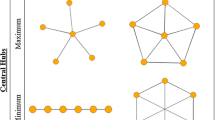Abstract
This paper analyzes the similarities between terrorist networks in Antiquity and cyberterrorist networks today. By establishing comparisons between networks from two classes of terrorists whose actions were recorded 2,000 years apart, this paper adds substance to the understanding of the superiority of networks to archetypical organizational structures (i.e., with a hierarchically-based order). By identifying three major factors, many analogies can be drawn, based on empirical statements found throughout this analysis, between cyberterrorist networks in this day and age and terrorist networks in Antiquity. Those factors are (1) similar patterns of communication, (2) similar connections and kinship webs, and (3) similar obstacles.
Similar content being viewed by others
References
Arquilla J, Ronfeldt D (2001) The advent of netwar (revisited): the future of terror, crime, and militancy. In: Arquilla J, Ronfeldt D (eds) Networks and netwars. RAND, Santa Monica, pp 1–28
Baker FW III (2008) Captured al Qaeda documents detail shift in support. Am Forces Press Serv 1:10–15
Baker WE, Faulkner RR (1993) The social organization of conspiracy: illegal networks in the heavy electrical equipment industry. Am Sociol Rev 58:837–860
Barabasi AL (2002) Linked: the new science of networks. Perseus, Cambridge, MA
Bavelas A (1950) Communication patterns in task-oriented groups. J Acoust Soc Am 22:725–730
Ben-Yehuda N (1998) Where Masada’s defenders fell. Biblic Archaeol Rev 24(6):32–39
Bilde P (1988) Flavius Josephus between Jerusalem and Rome: his life, his works, and their importance. Sheffield Academic, Sheffield
Block A (1979) East-side–west-side: organizing crime in New York 1939–1959. Christopher Davis, Swansea, UK
Brynjolfsson E, Mendelson H (1993) Information systems and the organization of modern enterprise. J Organ Comput 3:4
Chaliand G, Blin A (2007) The history of terrorism: from Antiquity to al Qaeda. University of California Press, Berkeley
Clem A, Galwankar S, Buck G (2003) Health implications of cyber-terrorism. Prehosp Disaster Med 18(3):272–275
Davidson J (1997) Courtesans and fishcakes: the consuming passions of classical Athens. Fontana, London
Degenne A, Forse M (1999) Introducing social networks. Sage, London
Denning DE (1999) Cyberterrorism. Testimony before the special oversight panel on terrorism committee on Armed Services U.S. House of Representatives, Georgetown University, DC
Denning DE (2001) Activism, hacktivism, and cyberterrorism. The internet as a tool for influencing foreign policy. In: Arquilla J, Ronfeldt D (eds) Networks and netwars. RAND, Santa Monica, CA, pp 239–288
Donath JS (1999) Identity and deception in the virtual community. In: Smith MA, Kollock P (eds) Communities in cyberspace. Routledge, New York, pp 29–59
Dunnigan JF (2003) The next war zone: confronting the global threat of cyberterrorism. Citadel, New York
Eco U (1986) Towards a semiological guerrilla warfare. In: Eco U (ed) Travels in hyperreality. Harcourt, San Diego, pp 135–144
Feldman LH, Hata G (1987) Josephus, judaism, and christianity. Wayne State University Press, Detroit
Fisher N (1998) Workshops of villains: was there much organised crime in classical Athens? In: Hopwood K (ed) Organised crime in Antiquity. Duckworth, London, pp 53–96
Freeman LC (1981) Social networks: a beginner’s bookshelf. Soc Netw 4(2):6–10
Gray R (1993) Prophetic figures in late second temple Jewish Palestine: the evidence from Josephus. Oxford University Press, Oxford
Greenberg E (2003) Mission-critical security planner: when hackers won’t take no for an answer. Wiley, New York
Heydebrand WV (1989) New organizational forms. Work Occup 16(3):323–357
Holmes L (2007) Terrorism, organised crime and corruption: networks and linkages. Edward Elgar, Northampton, MA
Hopwood K (1998) Bandits between grandees and the state: the structure of order in Roman Rough Cilicia. In: Hopwood K (ed) Organised crime in Antiquity. Duckworth, London, pp 177–206
Janczewski LJ, Colarik AM (2007) Cyber warfare and cyber terrorism. Idea Group, Hershey, PA
Johnson G (2000) First cells, then species, now the web. New York Times, p. M1, December 26
Josephus F (1982) The Jewish war. Steimatzky, Israel
Kenney M (2007) From Pablo to Osama: trafficking and terrorist networks, government bureaucracies, and competitive adaptation. Pennsylvania State University Press, Philadelphia
Klein H, Myers M (1999) A set of principles for conducting and evaluating interpretive field studies in information systems. MIS Q 23(1):67–93
Laqueur W (1999a) Terrorism and history. Oxford University Press, Oxford
Laqueur W (1999b) The new terrorism: fanaticism and the arms of mass destruction. Oxford University Press, Oxford
Leavitt HJ (1951) Some effects of certain communication patterns on group performance. J Abnorm Soc Psychol 46:38–50
Lenzner R, Vardi N (2007) The next threat. Forbes 174(5):15–21
Lipnack J, Stamps J (1986) The networking book: people connecting with people. Routledge and Kegan Paul, New York
Madorsky Elman N, Kennedy-Moore E (2003) The unwritten rules of friendship: simple strategies to help your child make friends. Little, Brown, and Company, New York
Maier P (1993) Flavius Josephus: the essential writings. Kregel, Grand Rapids, MI
Mansfield R (2000) Hacker attack. Sybex, San Francisco
Martin CA (2006) Understanding terrorism: challenges, perspectives, and issues. Sage, Thousand Oaks, CA
Matusitz J (2005) Deception in the virtual world: a semiotic analysis of identity. J New Media Culture 3(1):54–63
Matusitz J (2008) Postmodernism and networks of cyberterrorists. J Digital Forensic Practice 2:1–10
Matusitz J, O’Hair D (2007) The role of the Internet in terrorism. In: O’Hair D, Heath R, Ayotte K, Ledlow GR (eds) Terrorism: communication and rhetorical perspectives. Hampton, Cresskill, NJ
McNamara J (2003) Secrets of computer espionage: tactics and countermeasures. Wiley, Indianapolis
Mitchell S (1998) Native rebellion in the Pisidian Taurus. In: Hopwood K (ed) Organised crime in Antiquity. Duckworth, London, pp 155–175
Mitnick KD, Simon WL (2002) The art of deception: controlling the human element of security. Wiley, Indianapolis
Monge PR, Contractor NS (2001) Emergence of communication networks. In: Jablin FM, Putman LL (eds) The new handbook of organizational communication: advances in theory, research, and methods. Sage, Thousand Oaks, CA, pp 440–502
Monge PR, Contractor NS (2003) Theories of communication networks. Oxford University Press, New York
Monge PR, Fulk J (1999) Communication technology for global network organizations. In: Desanctis G, Fulk J (eds) Shaping organizational form: communication, connection, and community. Sage, Thousand Oaks, CA, pp 70–101
Pillar PR (2001) Terrorism and U.S. foreign policy. Brookings Institution Press, Washington, DC
Powell WW (1990) Neither market nor hierarchy: network forms of organization. Res Organ Behav 12:295–336
Raab J, Milward HB (2003) Dark networks as problems. J Public Adm Res Theory 13(4):413–439
Rajak T (1984) Josephus: the historian and his society. Fortress, Philadelphia
Ranstorp M (1994) Hizbollah’s command leadership: Its structure, decision-making and relationship with Iranian clergy and institutions. Terrorism Polit Violence 6(3):300–318
Regan T (1999) Balkans war reaches our corner of the Web. Christ Sci Monit 91(97):15
Report of the Defense Science Board Task Force on Information Warfare Defense (1996) Department of Defense, Washington, p. A3, November
Rosenthal U, Muller ER (2008) The evil of terrorism: diagnosis and countermeasures. Charles C., Thomas, Springfield, IL
Schneier B (1996) Applied cryptography. Wiley, New York
Schwartau W (2001) Cybershock: surviving hackers, phreakers, identity thieves, internet terrorists and weapons of mass disruption. Thunder’s Mouth, New York
Schwartz J (1999) Used to be, the internet was a safe place to play. Washington Post, p. C01, June 15
Schweitzer GE (2002) A faceless enemy: the origins of modern terrorism. Perseus, Cambridge, MA
Scott J (2000) Social network analysis: an introduction. Sage, New York
Scott J (2004) Social network analysis: a handbook. Sage, Thousand Oaks, CA
Shaw B (1990) Bandit highlands and lowland peace: the mountains of Isauria-Cilicia. J Econ Soc Hist Orient 33:199–233
Sheldon R (2005) Intelligence activities in Ancient Rome: trust the gods, but verify. Frank Cass, London, England
Simon H (1973) The structure of ill-structured problems. Artif Intell 4:181–201
Smith M (1971) Zealots and Sicarii: their origins and relation. Harv Theol Rev 64:1–19
Stallings W (1998) Cryptography and network security: principles and practice. Prentice Hall, New Jersey
Thackeray J (1968) Josephus: the man and the historian. Ktav, New York
Thornburgh N, Forney M, Bennett B, Burger TJ, Shannon E (2005) The invasion of the Chinese cyberspies (and the man who tried to stop them). Time 166(10):34–39
Verton D (2003) Black ice: the invisible threat of cyber-terrorism. McGraw-Hill, New York
Waits C, Shors D (1999) Unabomber: the secret life of Ted Kaczynski. Farcountry, Helena, MT
Wasserman S, Faust K (1994) Social network analysis. Cambridge University Press, Cambridge, MA
Watts DJ (2003) Six degrees: the science of a connected age. W. W. Norton & Company, New York
Wayner P (1996) Disappearing cryptography: setting up networks with hidden communications. AP Professional, Boston
Weimann G (2005) Cyberterrorism: the sum of all fears? Stud Confl Terror 48(2):129–149
Wellman B, Berkowitz SD (eds) (1988) Social structures: a network approach. Cambridge University Press, Cambridge, MA
Willis C (2001) Mob: stories of death and betrayal from organized crime. Thunder’s Mouth, New York
Zanini N, Edwards SJA (2001) The networking of terror in the information age. In: Arquilla J, Ronfeldt D (eds) Networks and netwars. RAND, Santa Monica, pp 29–60
Author information
Authors and Affiliations
Corresponding author
Rights and permissions
About this article
Cite this article
Matusitz, J. Similarities between terrorist networks in antiquity and present-day cyberterrorist networks. Trends Organ Crim 11, 183–199 (2008). https://doi.org/10.1007/s12117-008-9034-0
Received:
Accepted:
Published:
Issue Date:
DOI: https://doi.org/10.1007/s12117-008-9034-0




